Discover 35 hidden attractions, cool sights, and unusual things to do in Cotswold Water Park (United Kingdom). Don't miss out on these must-see attractions: St Andrew's Church, Bath Racecourse, and Crickley Hill and Barrow Wake. Also, be sure to include Somerset Monument in your itinerary.
Below, you can find the list of the most amazing places you should visit in Cotswold Water Park (England).
Table of Contents
St Andrew's Church
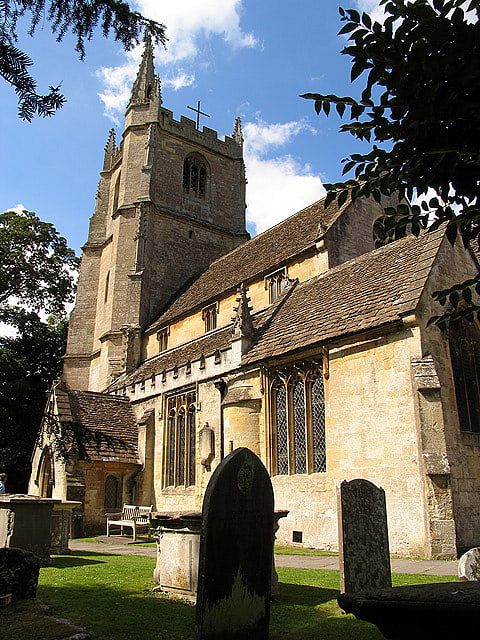
St Andrew's is a parish church in Castle Combe, Wiltshire built in the 13th century with additions in later centuries. It was restored due to structural concerns in the 19th century. It is a Grade I listed building.[1]
Address: Market Pl, SN14 7HT Chippenham
Bath Racecourse
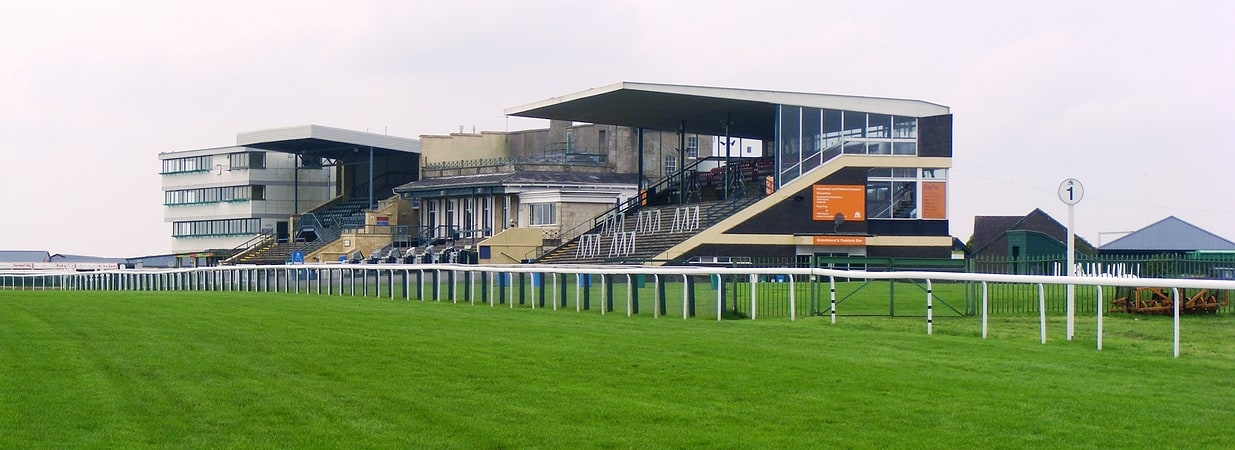
Arena in England. Bath Racecourse is a thoroughbred horse racing venue on Lansdown Hill, about 3+1⁄4 miles northeast of Bath, Somerset, England. It is owned and operated by Arena Racing Company.
The racecourse is a left-handed oval track of 1 mile 4 furlongs and 25 yards, with a run-in of nearly half-a-mile. The home straight is 4 furlongs, with a steady rise and turn. It is the highest flat racecourse in the country and has no watering facility, so the going can become very firm during a dry summer.
At 780 feet (238 m) above sea level, Bath is Britain's highest flat racecourse, although National Hunt courses Hexham and Exeter are higher.[2]
Crickley Hill and Barrow Wake
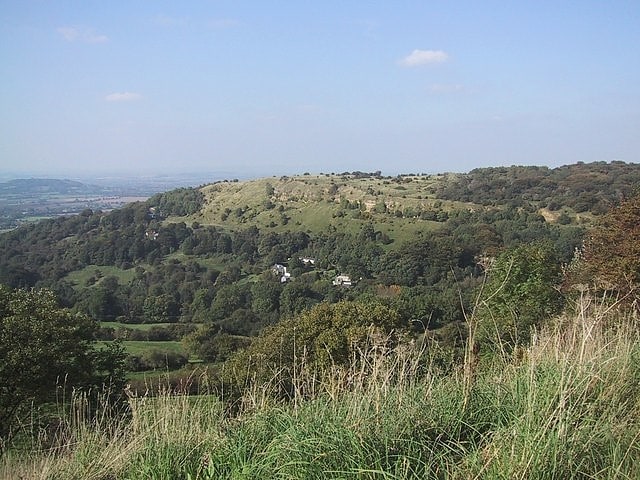
Crickley Hill and Barrow Wake is a 56.8-hectare biological and geological Site of Special Scientific Interest in Gloucestershire, notified in 1974.
The site (two parts) lies within the Cotswold Area of Outstanding Natural Beauty. It was formerly known as Crickley Hill and includes some of a site known as Tuffleys Quarry. Part of the site is owned and managed by Gloucestershire County Council and the National Trust as a Country Park. The Cotswold Way National Trail passes through Crickley Hill and Barrow Wake.
Barrow Wake and Tuffley's Quarry are listed in the 'Cotswold District' Local Plan 2001–2011 (on line) as Key Wildlife Sites. Crickley Hill is listed in the 'Cotswold District' Local Plan 2001–2011 (on line) as an SSSI and Regionally Important Geological Site.[3]
Somerset Monument
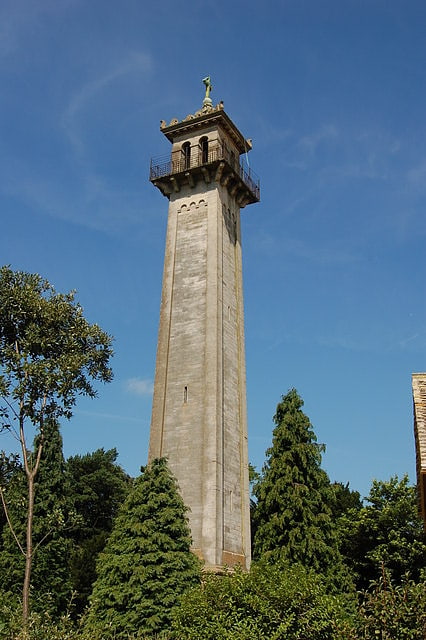
Historical landmark in England. The Somerset Monument in Hawkesbury Upton, Gloucestershire, England was built in 1846 to commemorate Lord Robert Edward Somerset. It is a Grade II* listed building, and on the Heritage at Risk register.[4]
Sezincote House

Sezincote House is the centre of a country estate in the civil parish of Sezincote, in the county of Gloucestershire, England. The house was designed by Samuel Pepys Cockerell, built in 1805, and is a notable example of Neo-Mughal architecture, a 19th-century reinterpretation of 16th and 17th-century architecture from the Mughal Empire. At the time of its construction, British India was becoming the "jewel in the crown" of the world's largest empire. According to Shashi Tharoor, the palace is an 'incongruous monument to the opulence of the nabobs' loot', referring to the construction of the palace using the wealth acquired by the East India Company's loot and plunder in Bengal.
Sezincote is dominated by its red sandstone colour, typical in Mughal architecture, but features a copper-covered dome instead of the typical white marble. The fenestration is composed of a sequence of extra-large windows with an arch-shape at the top. The arch, however, is not a simple or typical design, but instead a shell-like fan that is evidence of the Mughal influence. The interior design is more typical European style.
The landscape was designed by Humphry Repton. It is essentially a renaissance-style garden with elements of Hindu style, as seen in the crescent bridge with columns.[5]
Address: Near Moreton-in-Marsh GL56 9AW, Cotswold Water Park
Claverton Pumping Station
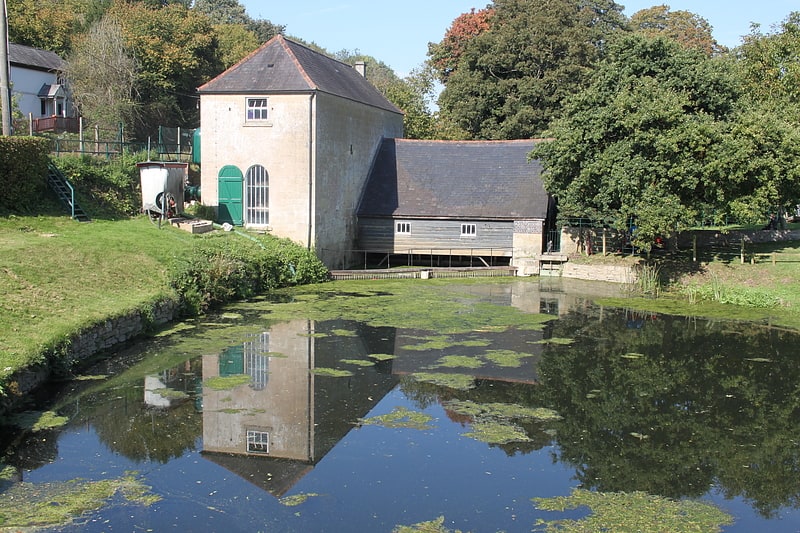
Tourist attraction in England. Claverton Pumping Station in the village of Claverton, in the English county of Somerset, pumps water from the River Avon to the Kennet and Avon Canal using power from the flow of the River Avon. It is a Grade I listed building, having been upgraded from Grade II in 2019.
The pumping station was built by John Rennie between 1809 and 1813 to overcome water supply problems on the canal. It uses a 24-foot (7 m) wide wooden breastshot water wheel to drive two Boulton and Watt 18-foot (5 m) long cast iron rocking beams, which power lift pumps to raise water 48 feet (15 m) up to the canal. The pumping station has undergone several modifications since its initial construction, including revising the wheel into two sections each 12 feet (3.7 m) wide separated by a 9-inch (23 cm) gap. The station's operational life ended in 1952, by which time its maintenance and repair had become uneconomical in the light of falling traffic on the canal.
In the 1960s and 1970s restoration was carried out by students from the University of Bath and the Kennet and Avon Canal Trust, who replaced and repaired the buildings and equipment and returned the pumping station to a functional state by 1978. It is now owned by the Canal and River Trust and maintained by the Claverton Pumping Station Volunteers, open to the public as an industrial heritage museum.[6]
Address: Ferry Lane, BA2 7BH Claverton
Newark Park

Tourist attraction in the Ozleworth, England. Newark Park is a Grade I listed country house of Tudor origins located near the village of Ozleworth, Wotton-under-Edge, Gloucestershire. The house sits in an estate of 700 acres at the southern end of the Cotswold escarpment with views down the Severn Valley to the Severn Estuary. The house and estate have been in the care of the National Trust since 1946.
Newark Park was originally a four-storey (three storeys over a basement) Tudor hunting lodge built between 1544 and 1556 for Sir Nicholas Poyntz (d.1557), whose main seat was at Acton Court near Bristol, some fifteen miles to the south, an easy day's ride. The Poyntz family were anciently feudal barons of Curry Mallet in Somerset, later of Iron Acton in Gloucestershire. Poyntz was a Groom of the Privy Chamber to Henry VIII and had recently remodeled Acton Park in anticipation of a royal visit. "Newark is equally fashionable in terms of its precocious classicism," observes Nicholas Cooper, who points out its rigorously symmetrical front (illustration), unprecedented in the main body of any great house in its time, and the correct Tuscan order of its original main door. The house was then called "New Work" and was partly constructed with building materials from the recently dissolved Kingswood Abbey, some five miles away. The lodge was three bays wide and of single-pile construction, one room deep. In the basement was a kitchen, there were two reception rooms on the ground floor and a banqueting room on the first. Modest sleeping quarters were provided on the third floor, and the roof was flat so that it could be used as a pleasurable lookout over the surrounding countryside, in which it enjoys a commanding position. It was built at about the same time as nearby Siston Court was being built by Sir Maurice Denys (d.1563), first cousin of Poyntz's wife Jane Berkeley. Poyntz's original lodge now forms the eastern part of the present structure.
In 1600 the lodge was sold to the Low family of London who in 1672 significantly extended the building by the addition of a second four-storey building to the west, which was joined to the original by a passage stairway creating an H-shaped footprint. The Lows owned Newark Park until 1722 when it was sold for £6,010 (equivalent to £967,000 today) to the Harding family who after making some minor alterations sold it to James Clutterbuck. The Clutterbucks engaged the architect James Wyatt to remodel it into a four-square house in 1790. Their improvements included the creation of a formal deer-park to the south of the house and landscaping of the rest of the grounds.
The Clutterbucks left Newark in 1860 and let it out, but even though it was tenanted the occupants continued to make alterations and improvements. Mrs Annie Poole King family, widow of a Bristol shipping merchant took the leasehold in 1898, moving from the larger Standish House at Stonehouse, Gloucestershire. A member of the Berkeley Hunt, she had five children, plus a house staff of a coachman, cook, housekeeper, and gardener. The King family added servants' quarters on the north side, installed a hot-air heating system and ran hot water to the second floor. The Kings stayed at Newark until 1949 when the last of the line died and the then owner, Mrs Power-Clutterbuck, gave Newark Park and its estates to the National Trust.
When the Trust took ownership they did not open Newark Park to the public but instead let it out to tenants who ran it as a nursing home. By 1970 the house was in a state of disrepair and the gardens overgrown. It was in this state that American architect Robert (Bob) Parsons (1920–2000), who had long expressed a desire to take on an English country house in need of repair, took the tenancy and began a painstaking programme of renovation, conservation and rehabilitation to both the house and the grounds. It was due to Bob Parson's efforts that the architectural importance of the house was acknowledged and the Grade I listing achieved. Parson's partner, Michael Claydon, moved to Newark Park in 1982 and became actively involved in the ongoing restoration. After Parson's death in 2000, Claydon maintained stewardship of the house and continued restoration works in the landscaped parkland.[7]
Solsbury Hill
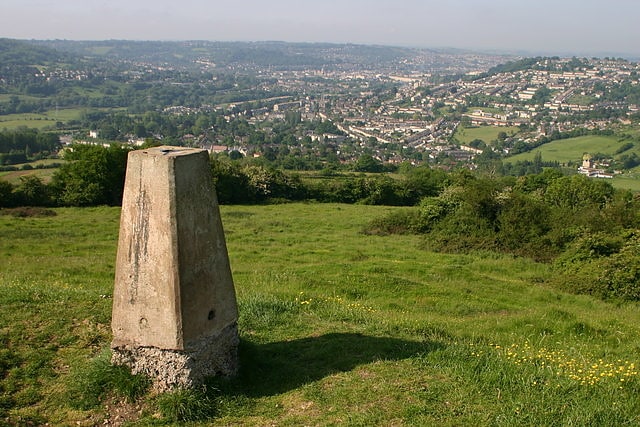
Hill in England. Little Solsbury Hill is a small flat-topped hill and the site of an Iron Age hill fort. It is located above the village of Batheaston in Somerset, England. The hill rises to 625 feet above the River Avon, which is just over 1 mile to the south, and gives views of the city of Bath and the surrounding area. It is within the Cotswolds Area of Outstanding Natural Beauty.
The hill is one of several possible locations of the Battle of Badon and shows the remains of a medieval field system. Part of the hill was quarried in the 19th century. In 1930, it was acquired by the National Trust. The hill was the inspiration of the Peter Gabriel song "Solsbury Hill", recorded in 1977. A small turf labyrinth was cut into the turf by protesters during the widening of the A46 in 1994.[8]
Blockley Church

Christian church in Blockley, England. The Church of St Peter and St Paul is a Church of England parish church in Blockley, Gloucestershire, England. The church is a Grade II* listed building.[9]
Address: The Square, Cotswold Water Park
Leckhampton Hill and Charlton Kings Common
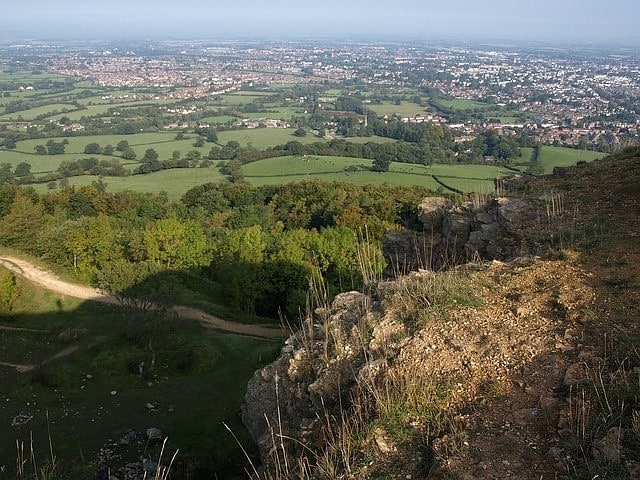
Park in Cheltenham, England. Leckhampton Hill and Charlton Kings Common is a 63.8-hectare biological and geological Site of Special Scientific Interest in Gloucestershire, notified in 1954. There are five units of assessment.
The site is listed in the 'Cotswold District' Local Plan 2001-2011 (on line) as a Key Wildlife Site (KWS).[10]
St Laurence's Church
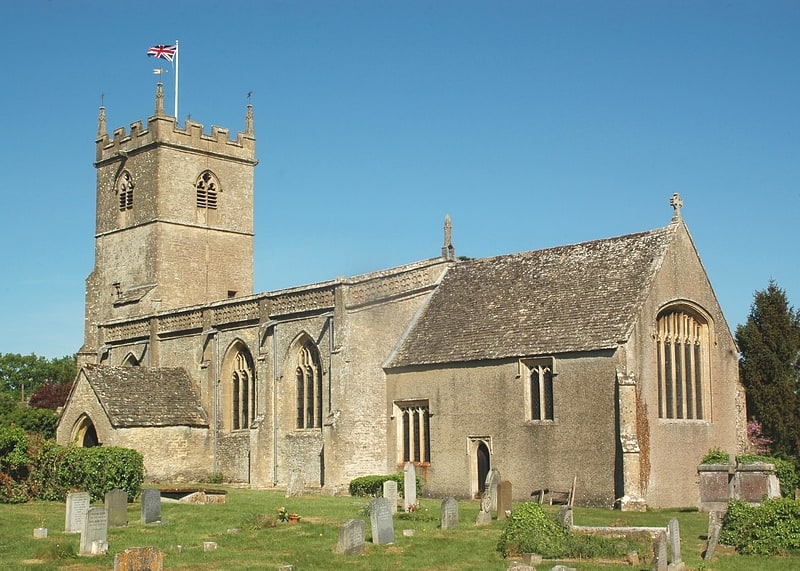
Church in Combe, England. St Laurence's Church, Combe Longa is the Church of England parish church of Combe, Oxfordshire, England. The parish is part of the Benefice of Stonesfield with Combe Longa.
The Wychwood Way long-distance footpath passes the church.[11]
Address: Church Walk, OX29 8NG Coombe
Wychwood
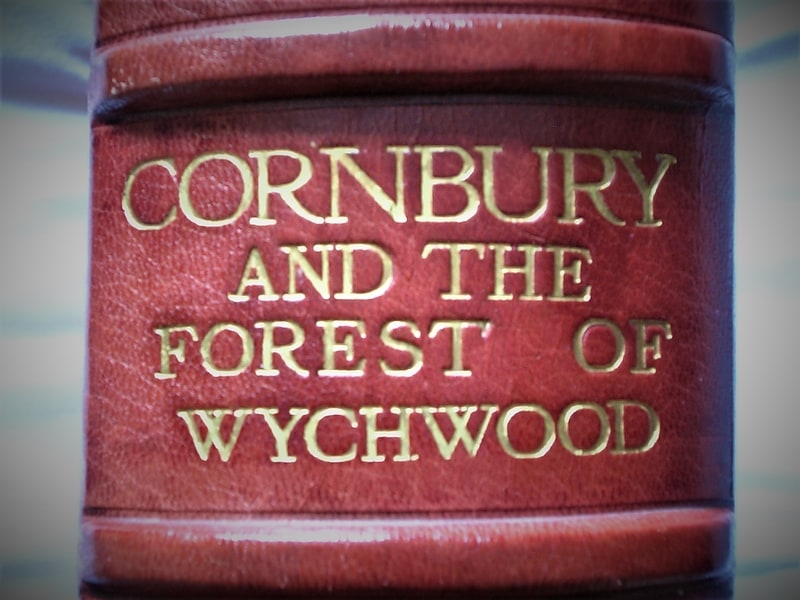
Wychwood or Wychwood Forest is a 501.7-hectare biological Site of Special Scientific Interest north of Witney in Oxfordshire. It is also a Nature Conservation Review site, Grade 1, and an area of 263.4 hectares is a national nature reserve The site contains a long barrow dating to the Neolithic period, which is a scheduled monument.
In past centuries the forest covered a much larger area, since cleared in favour of agriculture, villages and towns. However, the forest's area has fluctuated. Parts cleared for agriculture during Britain's centuries under Roman rule later reverted to forest. The existence of the ancient Wychwood is recognised by the authoritative Victoria County History, but the planned Volume XIX has yet to be completed.[12]
St Michael and St Martin's Church
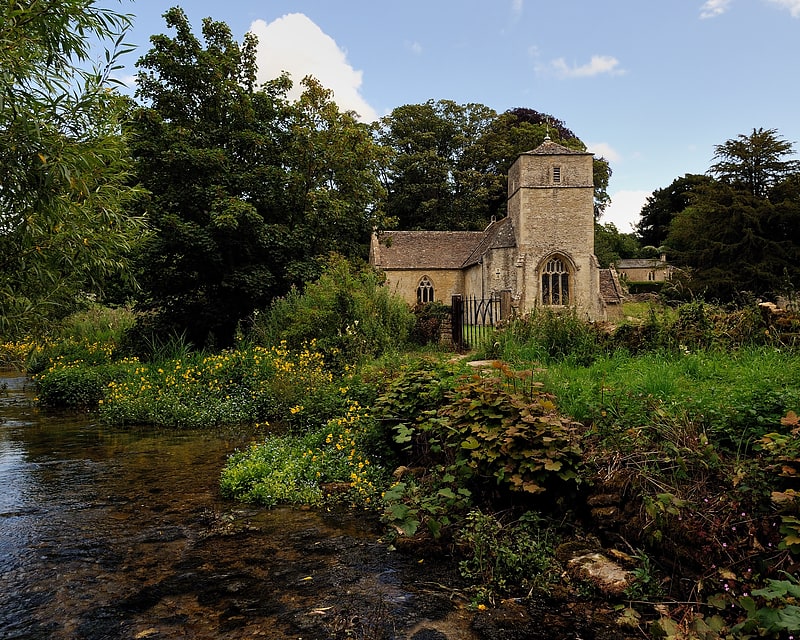
Church in England. St Michael and St Martin's Church is a historic Anglican church in Eastleach Martin, Gloucestershire, England under the care of The Churches Conservation Trust. It is recorded in the National Heritage List for England as a designated Grade I listed building. The church stands close to the River Leach which divides Eastleach Martin from its twin village of Eastleach Turville. Eastleach Turville's Church of St Andrew stands only 180 metres away from the Church of St Michael and St Martin.[13]
Address: Eastleach Martin, Cotswold Water Park
St Andrew's Church
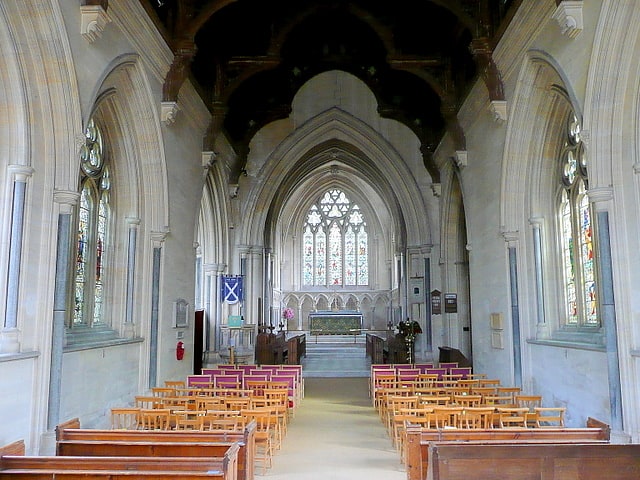
Christian church in Toddington, England. St Andrew's Church, Toddington is a Grade I Listed Building in the town of Toddington, Gloucestershire, England. The present church is the third to occupy the site.[14]
Address: The Square, GL54 5DJ Cheltenham
St James' Church
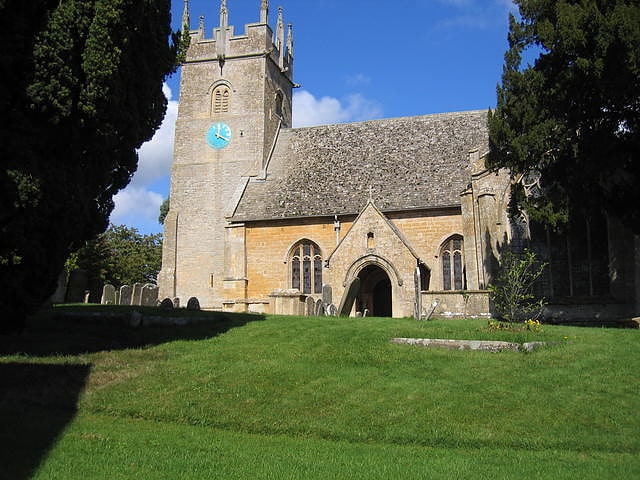
Building in Longborough, England. St James' Church is the Church of England parish church of Longborough, Gloucestershire, England. It is in the deanery of Stow, the archdeaconry of Cheltenham and the diocese of Gloucester. Its benefice is combined with those of St David, Moreton-in-Marsh, St Mary, Batsford, St Thomas of Canterbury, Todenham, and St Leonard, Lower Lemington. It contains fabric from the 12th century and is recorded in the National Heritage List for England as a designated Grade I listed building.[15]
Tyndale Monument
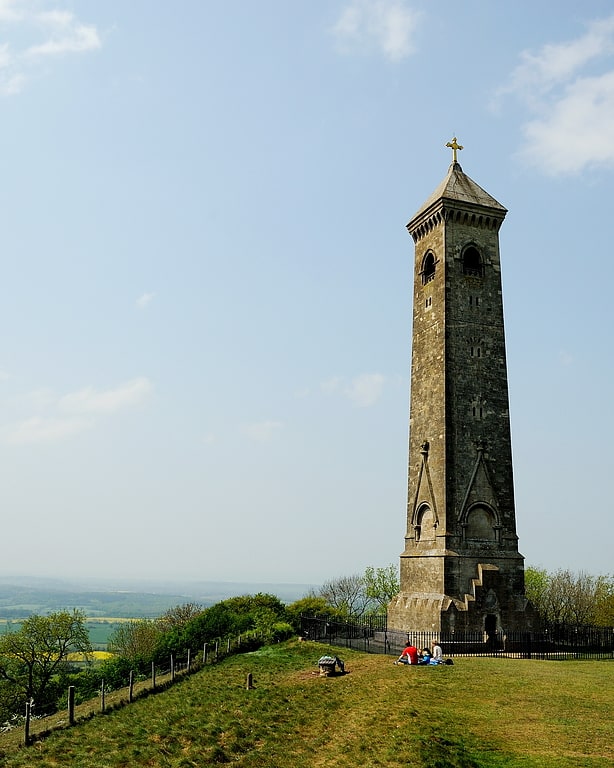
Monument in England. The Tyndale Monument is a tower built on a hill at North Nibley, Gloucestershire, England. It was built in honour of William Tyndale, an early translator of the New Testament into English, who was born nearby. It is a Grade II* listed building.
The tower was constructed in 1866 and is 111 ft (34 m) tall. It is possible to enter and climb to the top of the tower, up a spiral staircase of 121 steps. The hill it is on allows a wide range of views, especially looking down to the River Severn. A nearby topograph points to some other landmarks visible. The hill on which the monument stands is quite steep. The path follows a rough fairly steep bridleway which is part of the Cotswold Way. The tower itself is surrounded by fencing and has floodlights that light up the tower at night. The stairway has automatic lighting. The Cotswold Way long-distance footpath passes the foot of the monument, and then descends the hill into North Nibley.
The door to the tower is always open. Locally, it is commonly called Nibley Monument rather than its official name. The hill is called Nibley Knoll or occasionally Nibley Knob.
There is a commemorative plaque on the front of the tower. The text engraved on it reads:
ERECTED A.D. 1866IN GRATEFUL REMEMBRANCE OFWILLIAM TYNDALETRANSLATOR OF THE ENGLISH BIBLEWHO FIRST CAUSED THE NEW TESTAMENTTO BE PRINTED IN THE MOTHER TONGUEOF HIS COUNTRYMENBORN NEAR THIS SPOT HE SUFFEREDMARTYRDOM AT VILVORDEN INFLANDERS ON OCT 6 1536The monument is a landmark that can be seen for miles, even in places as far as Bristol over 20 miles away. In the town of Thornbury there is a street called Tyndale View where the tower can be seen from approximately 10 miles away.
Further down the Cotswold Edge, at Hawkesbury, is the Somerset Monument, erected in 1846, and the design of the Tyndale tower has features in common with this.
In October 2019 protesters from Extinction Rebellion used the monument to display a protest banner.[16]
Horton Court
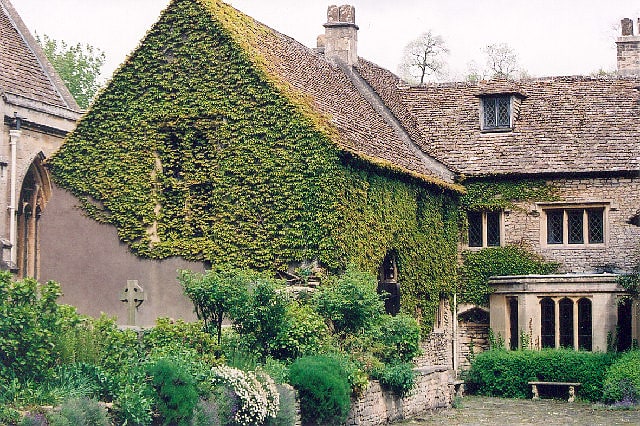
Housing. Horton Court is a stone-built 16th century manor house in Horton, near Chipping Sodbury, South Gloucestershire, England. It is a grade I listed building.
The house was built in about 1521 by Rev. William Knight (d. 1547), Prothonotary to the Holy See, and later Bishop of Bath and Wells. It retains a 12th-century Norman hall, and displays some of the earliest Renaissance decorative motifs used in England. Within the grounds is a grade I listed ambulatory, built for William Knight around 1527-29.
It has been owned by the National Trust since 1949. As of 2021, it is available for holiday lets.
The parish church of St James the Elder is next door.[17]
St Michael's and All Angels Church
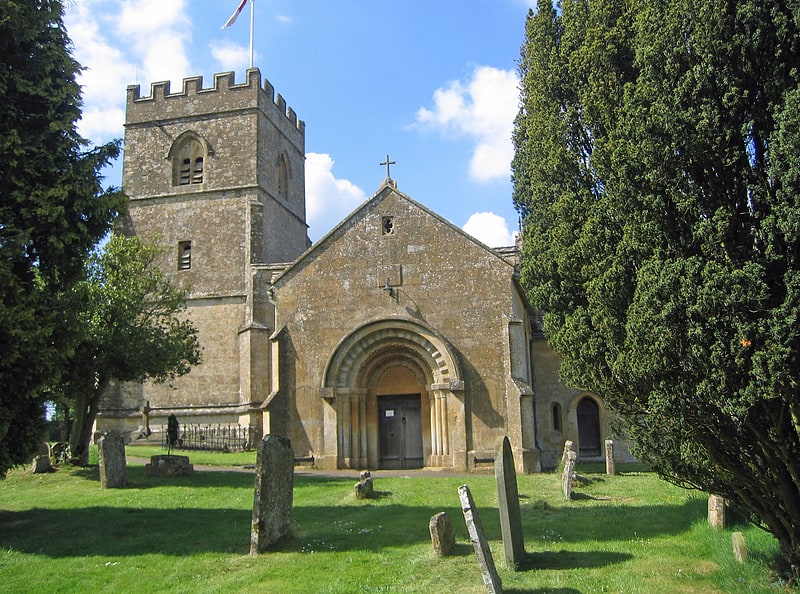
Building in the United Kingdom. St Michael's and All Angels Church is in the village of Guiting Power, Gloucestershire, England. It is an active Anglican parish church in the deanery of Stow, the archdeaconry of Cheltenham and the diocese of Gloucester. Its benefice is combined with those of St Faith, Farmcote, St Mary, Lower Slaughter, St Andrew, Naunton, St Mary, Temple Guiting, St James, Cutsdean, and St Peter, Upper Slaughter. The church contains fabric dating from the 12th century and is recorded in the National Heritage List for England as a designated Grade II* listed building. It formerly stood in the centre of the village, but the demolition of buildings since 1900 has left it standing at the village's southern end.[18]
Nympsfield Long Barrow
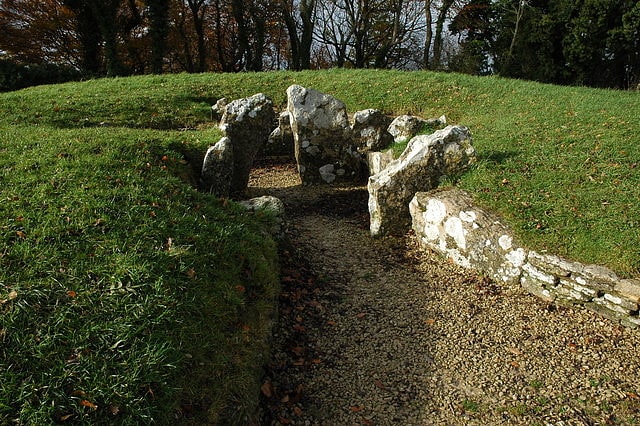
Historical landmark in England. Nympsfield Long Barrow is the remains of a Neolithic burial site or barrow, located close to the village of Nympsfield in Gloucestershire, South West England.
It lies at the edge of a woods, and is now the location of a picnic site. It is one of the earliest examples of a barrow with separate chambers. It was constructed around 2800 BCE.
It is a Scheduled Monument (number 22857) in the guardianship of English Heritage.
Many of the finds from excavations at this site are now in the Gloucester City Museum.[19]
Coaley Peak
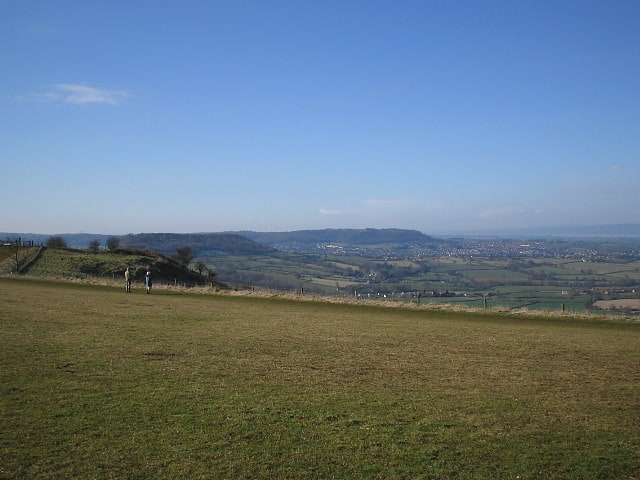
Scenic spot in England. Coaley Peak is a picnic site and viewpoint in the English county of Gloucestershire.
Located about 4 miles (6.4 km) south-west of the town of Stroud overlooking the village of Coaley, Coaley Peak offers 12 acres (4.9 ha) of reclaimed farmland (now a wild flower meadow) with views over the Severn Vale and the Forest of Dean. It is next to a Woodland Trust beech wood and the National Trust's Frocester Hill site. The Cotswold Way long-distance footpath passes through the site. The site includes the excavated Neolithic burial site Nympsfield Long Barrow.
Coaley Peak was for many years a seasonal home to a community of new age travellers, who were evicted around 2002 to make way for more grassland.[20]
Church of St Peter

Church in Freshford, Somerset, England. The Anglican Church of St Peter in Freshford within the English county of Somerset dates from the 15th century. It is a Grade II* listed building.
Parts of St Peter's Church, which is on the north side of the village, date back to the fifteenth century. The three stage tower, which is supported by diagonal buttresses, was added in 1514. The church underwent Victorian restoration by Charles Edward Davis.
The churchyard has a number of Georgian chest tombs, dating from the late 18th and early 19th century, four of which are listed in their own right.
The parish is part of the benefice of Freshford with Limpley Stoke and Hinton Charterhouse within the Diocese of Bath and Wells.[21]
Address: Church Hill, BA2 7TX Bath
Badminton House
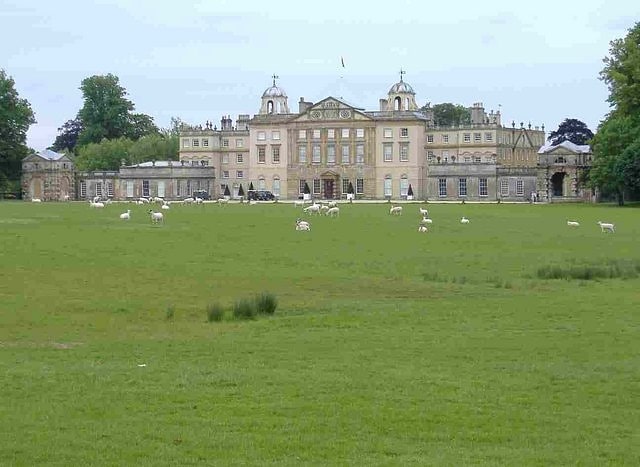
Building in Badminton, England. Badminton House is a large country house and Grade I Listed Building in Badminton, Gloucestershire, England, which has been the principal seat of the Dukes of Beaufort since the late 17th century. The house gives its name to the sport of badminton and is set among 52,000 acres of land. The gardens and park surrounding the house are listed at Grade I on the Register of Historic Parks and Gardens.[22]
Church of the Holy Cross
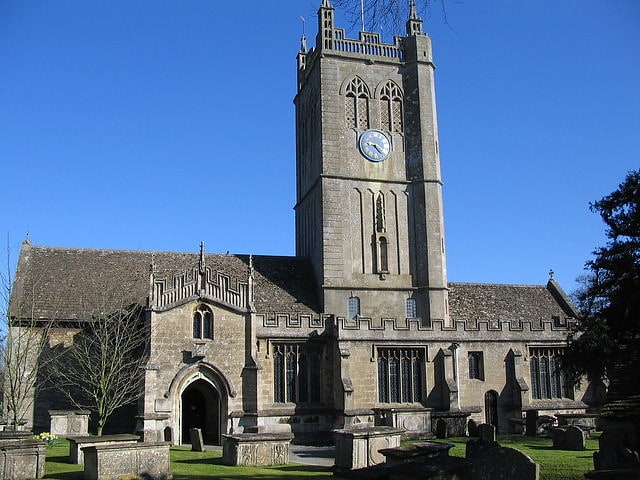
The Church of the Holy Cross is the Anglican church in the village of Sherston, Wiltshire, England. It is Norman and contains many interesting religious items, including remains of Norman wall decoration, and a crucifix donated to the church by Italian soldiers during World War II. Sung Eucharist is held at the church every Sunday at 9.30 am and the church is also open every day for silent prayer.
The church is Grade I listed.[23]
Address: 1 Church St, Sherston, Malmesbury SN16 0LR, Cotswold Water Park
St Nicholas of Myra's Church
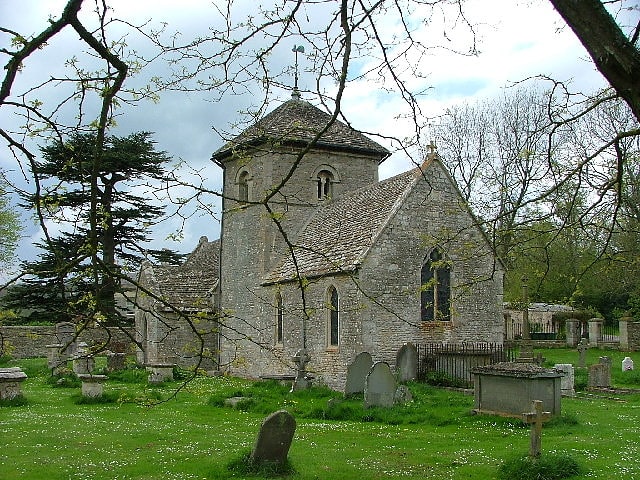
Church in England. St Nicholas of Myra's Church is a redundant Anglican church in the village of Ozleworth, Gloucestershire, England, in the care of The Churches Conservation Trust. It is recorded in the National Heritage List for England as a designated Grade II* listed building. The church is unusual because it is one of only two churches in Gloucestershire with a hexagonal tower, the other being St Lawrence's Church in Swindon. You can find the church by following signs for 'Historic Church' and for Newark Park nearby. By car, park outside the Ozleworth Estate, near to the gates, and follow a long bridle path downhill and around to the left until you reach the churchyard. Please note - the path can be muddy and slippery.[24]
All Saints Church

Church in England. All Saints Church is the parish church for Selsley in Gloucestershire.[25]
Lodge Park and Sherborne Estate

Building in Aldsworth, England. Lodge Park was built as a grandstand in the Sherborne Estate near the villages of Sherborne, Aldsworth and Northleach in Gloucestershire, England. The site is owned by the National Trust and the former grandstand is recorded in the National Heritage List for England as a designated Grade I listed building. It is England's only surviving 17th-century deer course and grandstand.
In the 19th century Lodge Park was modified into a house, then a row of cottages, and then into a house again. It was bequeathed to the National Trust in 1982, and restored to its original form as a grandstand. Lodge Park is open to the public at advertised times, and the footpaths in the Sherborne Estate are available to the public at all times.[26]
Address: Lodge Park, GL54 3PP Aldsworth
Midford Castle
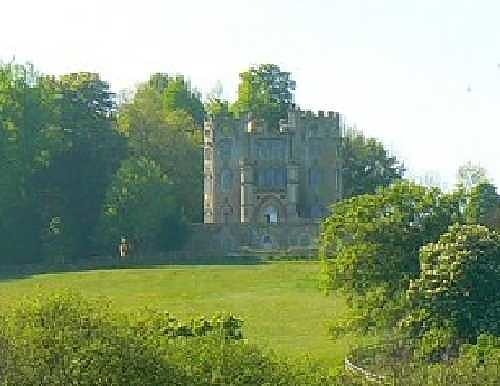
Building in England. Midford Castle is a folly castle in the village of Midford, and the parish of Southstoke 3 miles south of Bath, Somerset, England.
The castle was built in 1775 for Henry Disney Roebuck from designs by John Carter in the shape of the "clubs" symbol used in playing cards (♣). It has been suggested, originally in a magazine article in 1899, that he asked for the clubs design to represent an ace of clubs because he had obtained the money for the castle from gambling on a card game, but this is unlikely, as the porch which creates the "stem" of the symbol was added later. It is more likely that the layout was taken from an article which had been published in Builder's Magazine in 1774. The house has a sub triangular or trefoil plan formed by 3 semi-circular towers conjoined in a gothic style. It has been designated by English Heritage as a Grade I listed building.
In 1810, the castle was bought by one of the Conollys of Castletown House in County Kildare, who added the porch (said to give the clubs symbol its stalk) and built the nearby stables and chapel, known as the priory. The latter fell into disrepair after the last of the Conollys sold the house in 1901.
Soon after 1810 Kingham Field, which was part of the estate, was operating as a stone quarry similar to the nearby Combe Down and Bathampton Down Mines. William Smith, who became known as "Father of English Geology", proposed conveying the stone by a railway down to Tucking Mill where it would be sawn by machinery, and then loaded on to canal barges and transported via the Somerset Coal Canal and the Kennet and Avon Canal to Bath and London. In April 1814, Smith mortgaged the remainder of his estate to Charles Conolly who then controlled the railway and probably extended it to his Vinegar Down Quarry. The scheme failed and in 1819 Conolly had Smith committed to the King's Bench Prison for debt and took over the sawmill and Smith's house at Tucking Mill.
Michael Fenwick Briggs and his wife Isabel (better known by her pen name of Isabel Colegate) bought Midford in 1961 and carried out extensive renovation work; which included incorporating the chapel into the garden as a picturesque ruin.
In July 2007, the castle was sold to actor Nicolas Cage for £5 million. Cage sold the castle in 2009.
The castle is listed Grade I on the National Heritage List for England. The castle grounds also include the Grade II listed archway with lodge and screen wall, a pair of gatepiers and gates, and the Grade II* listed group of the stables, old chapel, walls enclosing the stable yard, coach house and greenhouse. The priory 500 yards to the north east of the castle is Grade II listed.[27]
Avening Valley
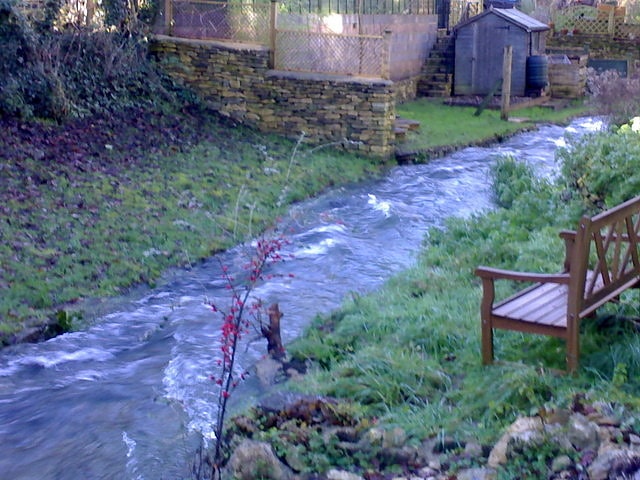
The Avening Valley is located in the South Cotswolds in England, running roughly east from Nailsworth and through the village of Avening.
During the 17th century the cloth industry developed in the Avening Valley, with mills powered by the Avening Stream. One of the larger cloth mills was named the Holcombe Mill (an old "gig" mill), which was adapted in 1879 for manufacture of bedding. Another is at Longfords Mills, Minchinhampton.[28]
Address: 29 High Street, Cotswold Water Park
Church of St James

Parish church in Southstoke, England. The Church of St James is an Anglican parish church in Southstoke, Somerset, England. It was built in the 12th century and has been designated as a Grade II* listed building.
Dedicated to James, son of Zebedee, known in England as St James the Great, the original 12th-century building was altered in the 15th century. Further restoration was undertaken in the 1840s and 1850s when the chancel and south aisle were rebuilt. However, the north door is Norman. Pevsner says of it
Low Perp. w. tower. Nave with Norman n. doorway. One order of columns, both patterned with a lozenge design, but the r. one in addition with two alternating smaller motifs in the lozenges. Lintel with low-pitched top, chip-carved. Tympanum with a trellis pattern of roll-mouldings. Arch with rosettes, three-dimensional zigzag and a kind of flat plait. S. aisle and chancel 1845 and c. 1850. Pulpit – stone, polygonal, probably Perp.
Pevsner also noted in the 1950s that the church plate included an Elizabethan chalice and a paten by Thomas Parr marked for the year 1700.
The parish is part of the benefice of Combe Down with Monkton Combe and South Stoke within the archdeaconry of Bath.[29]
St Michael's Church
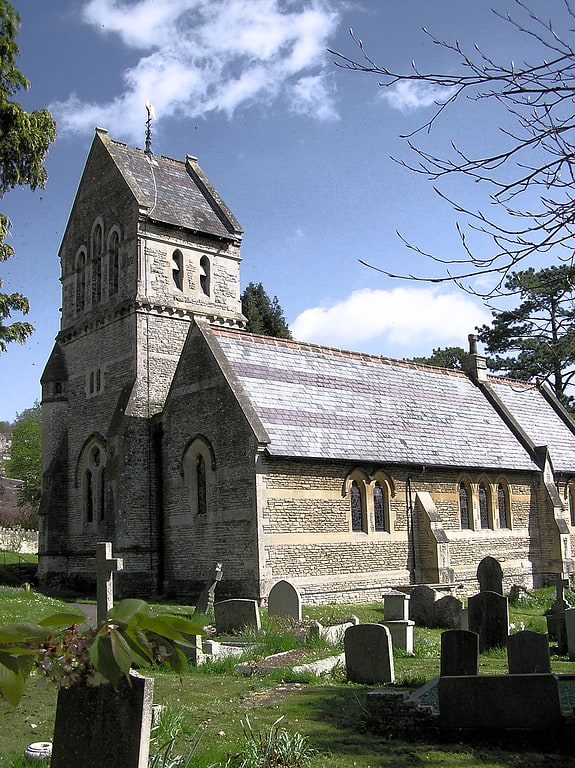
Building in the United Kingdom. St Michael's Church is the Church of England parish church of Monkton Combe, Somerset, England. It was also the parish church of Combe Down until the 1850s when the communities separated. It is a Grade II listed building.[30]
Badminton House
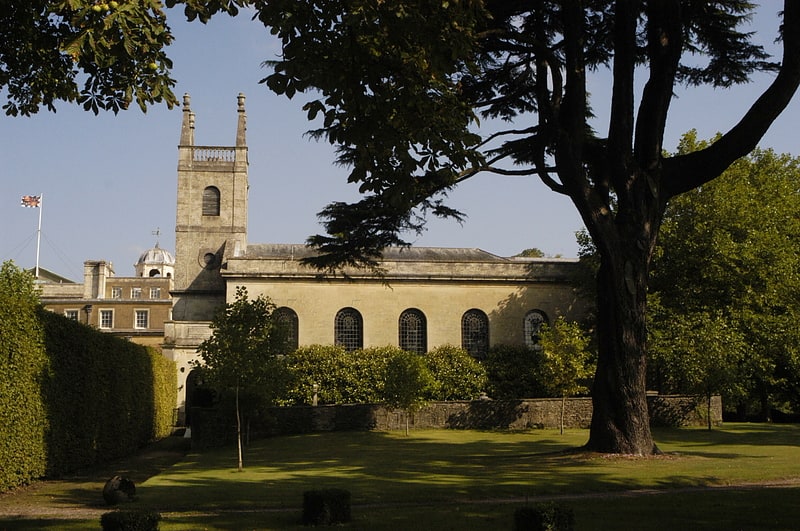
Church in England. St Michael and All Angels is a Grade I listed church on the estate of the Duke of Beaufort in the village of Great Badminton, Gloucestershire, England. Attached to the Duke of Beaufort's residence, Badminton House, it is an active Anglican parish church in the diocese of Gloucester. Although within the grounds of the Badminton Estate, the church is owned, and its upkeep met, by the Badminton's Parochial Church Council, rather than the Ducal estate. There is a smaller church of the same name in the neighbouring hamlet of Little Badminton.[31]
Moreton-in-Marsh and Batsford War Memorial
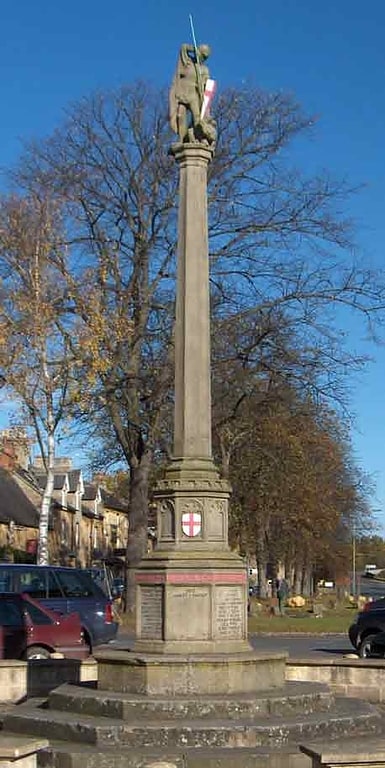
Historical landmark in Moreton-in-Marsh, England. Moreton-in-Marsh and Batsford War Memorial stands in Moreton-in-Marsh, Gloucestershire, England, and is a memorial to those of Moreton and Batsford killed in the First and Second World Wars. The erection of the memorial on the High Street began in November 1920. It is built of Hollington stone from Staffordshire, and stands 24 feet high. The work was carried out by R. I. Boulton and Sons of Cheltenham to Guy Dawber's design. Carved at the top of the memorial are the figures of St. George and the Dragon from the model prepared by the sculptor, Allan Wyon of London. The total cost was around £700, raised primarily from public subscriptions.
The memorial consists of an octagonal flight of five steps, upon which stands a sur-base containing panels and surmounted around the top by the inscription "In grateful memory of the men of Moreton and Batsford who gave their lives in the Great War". On four panels are inscribed the names of the forty-four men who died. On a fifth panel was later inscribed "These men also gave their lives 1939-1945" with the names of seven men who fell in the Second World War.
On the sur-base is superimposed another base block with cusped and traceried panels containing the arms of the County of Gloucestershire and of St. George emblazoned in colour and gilt. Above this rises an octagonal shaft crowned by the carved figure of St. George and the Dragon.
The unveiling took place on the afternoon of Saturday 26 March 1921, when there was a large crowd from Moreton and the surrounding villages. Over seventy of the local branch of the Comrades of the Great War paraded under Captain Henderson, as did the Girl Guides under Miss D. Southorn, the Boy Scouts under Scoutmaster Haines, and nurses from the VAD Hospital at Kitebrook under their Commandant, Mrs Pritchard OBE.
Sir Gilbert Wills of Batsford Park gave a brief address before the monument was formally unveiled by Lord Redesdale.
In 2001, a further "peacetime" casualty was added to the memorial. In 2018 the name of a female SOE agent killed in a concentration camp in 1944 was added.
The book Moreton in Marsh & Batsford War Memorial ISBN 0-907616-36-4 by war memorial researcher Kenneth Fowler was written about this War Memorial and all those commemorated upon it and includes the military burials in Moreton-in-Marsh cemetery.[32]
St Catherine's Court
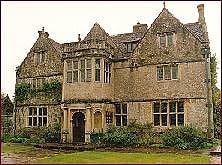
Manor house in England. St Catherine's Court is a manor house in a secluded valley north of Bath, Somerset, England. It is a Grade I listed property. The gardens are Grade II* listed on the Register of Historic Parks and Gardens of special historic interest in England.
The original house was a priory grange for the monks of Bath Abbey adjacent to the Church of St Catherine. At the Dissolution of the Monasteries, the manor was granted to John Malte and passed down to the courtier John Harington. It was bought in 1591 by John Blanchard and housed his descendants for generations, but the property fell into disrepair. In the 19th century, the house was bought by Colonel Joseph Holden Strutt who renovated it, with the work being continued by his sons. In 1984, actress Jane Seymour bought the house and carried out further renovation. During her ownership, the property was used as a recording studio and party venue, which caused complaints among the neighbours. It has since been further extended and is now rented out as a wedding venue.
The fabric of the building has changed over the centuries with a two-storey porch being added in 1610. Further extensions were added in the early 19th century, and the orangery and library were added in the early 20th century. In the 21st century, another addition including a swimming pool was added. The house is surrounded by 4 hectares (9.9 acres) of landscaped grounds with terraces joined by flights of steps. The barn within the grounds is from the 13th to 15th centuries.[33]
Church of St Julian
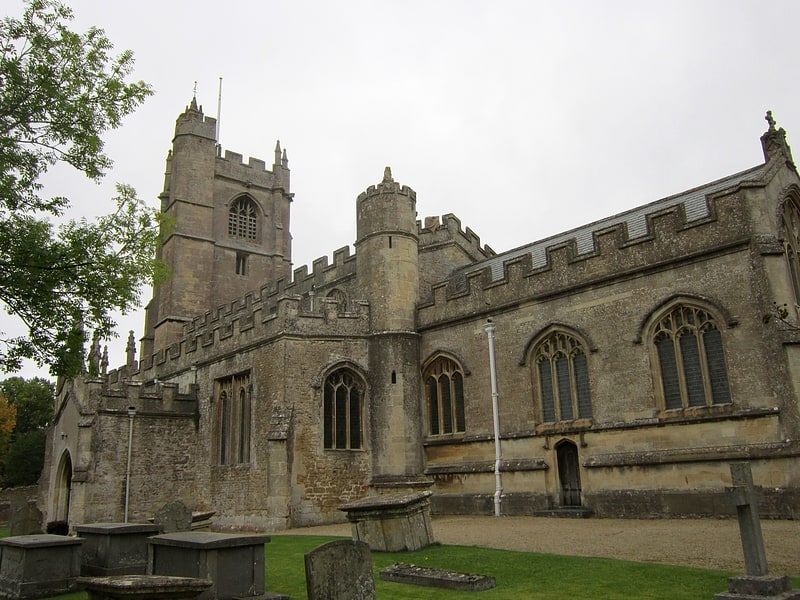
The Church of St Julian in Wellow, Somerset, England has origins before the 12th century although the present building dates from 1372. It has been designated as a Grade I listed building.[34]
All Saints Church
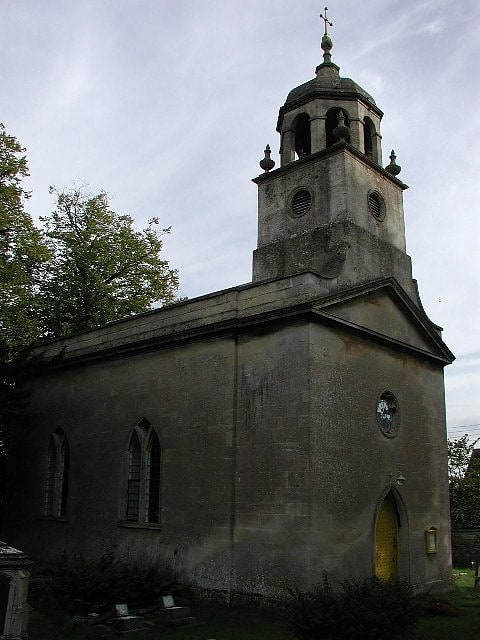
Church in Woolley, England. All Saints Church at Woolley in the parish of Charlcombe, Somerset, England, dates from 1761 and was built by John Wood, the Younger replacing an earlier church on the site. It is a Grade I listed building.
The church has a nave and apsidal sanctuary topped by a small bell tower with an octagonal cupola. The pews were brought in from another church in Bath to replace the original box pews in 1903.
Within the church is a plaque giving thanks for the safe return of all 13 men from the village who fought in World War I and 15 in World War II, making it one of the Thankful villages.
From the 1970s to 1990s the church underwent significant restoration funded by local residents and the Friends of Wooley Church.
The parish is part of the benefice of Bath St Saviour with Swainswick and Woolley, within the deanery of Bath.[35]
Address: Church St, BA1 8AS Bath